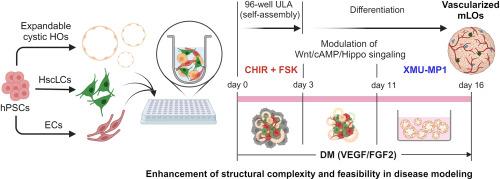Optimization of culture conditions to generate vascularized multi-lineage liver organoids with structural complexity and functionality
IF 12.8
1区 医学
Q1 ENGINEERING, BIOMEDICAL
引用次数: 0
Abstract
Hepatic organoids (HOs), primarily composed of hepatobiliary cells, do not represent the pathogenesis of liver diseases due to the lack of non-parenchymal cells. Multi-lineage liver organoids (mLOs) containing various cell types found in the liver offer a promising in vitro disease model. However, their structural complexity remains challenging to achieve due to the difficulty in optimizing culture conditions that meet the growth need of all component cell types. Here, we demonstrate that cystic HOs generated from hPSCs can be expanded long-term and serve as a continuous source for generating complex mLOs. Assembling cystic HOs with hPSC-derived endothelial and hepatic stellate cell-like cells under conventional HO culture conditions failed to support the development of multiple cell types within mLOs, resulting in biased differentiation towards specific cell types. In contrast, modulating the cAMP/Wnt/Hippo signaling pathways with small molecules during assembly and differentiation phases efficiently generate mLOs containing both hepatic parenchymal and non-parenchymal cells. These mLOs exhibited structural complexity and functional maturity, including vascular network formation between parenchymal lobular structures, cell polarity for bile secretion, and the capacity to respond to fibrotic stimuli. Our study underscores the importance of modulating signaling pathways to enhance mLO structural complexity for applications in modeling liver pathologies.

优化培养条件,生成具有结构复杂性和功能性的血管化多系肝脏器官组织。
肝脏器质性组织(HOs)主要由肝胆细胞组成,由于缺乏非实质性细胞,因此不能代表肝脏疾病的发病机制。多线肝脏器官组织(mLO)包含肝脏中的各种细胞类型,是一种很有前景的体外疾病模型。然而,由于难以优化培养条件以满足所有组成细胞类型的生长需要,要实现其结构的复杂性仍然具有挑战性。在这里,我们证明了由 hPSCs 生成的囊性 HOs 可以长期扩增,并可作为生成复杂 mLOs 的持续来源。在传统的 HO 培养条件下,用 hPSC 衍生的内皮细胞和肝星状细胞样细胞组装囊性 HO 无法支持 mLO 内多种细胞类型的发育,导致细胞偏向于特定类型的分化。与此相反,在组装和分化阶段用小分子调节cAMP/Wnt/Hippo信号通路,可有效生成包含肝实质细胞和非肝实质细胞的mLO。这些mLO表现出结构的复杂性和功能的成熟性,包括实质小叶结构之间血管网络的形成、胆汁分泌的细胞极性以及对纤维化刺激做出反应的能力。我们的研究强调了调节信号通路以增强mLO结构复杂性在肝脏病理建模中应用的重要性。
本文章由计算机程序翻译,如有差异,请以英文原文为准。
求助全文
约1分钟内获得全文
求助全文
来源期刊

Biomaterials
工程技术-材料科学:生物材料
CiteScore
26.00
自引率
2.90%
发文量
565
审稿时长
46 days
期刊介绍:
Biomaterials is an international journal covering the science and clinical application of biomaterials. A biomaterial is now defined as a substance that has been engineered to take a form which, alone or as part of a complex system, is used to direct, by control of interactions with components of living systems, the course of any therapeutic or diagnostic procedure. It is the aim of the journal to provide a peer-reviewed forum for the publication of original papers and authoritative review and opinion papers dealing with the most important issues facing the use of biomaterials in clinical practice. The scope of the journal covers the wide range of physical, biological and chemical sciences that underpin the design of biomaterials and the clinical disciplines in which they are used. These sciences include polymer synthesis and characterization, drug and gene vector design, the biology of the host response, immunology and toxicology and self assembly at the nanoscale. Clinical applications include the therapies of medical technology and regenerative medicine in all clinical disciplines, and diagnostic systems that reply on innovative contrast and sensing agents. The journal is relevant to areas such as cancer diagnosis and therapy, implantable devices, drug delivery systems, gene vectors, bionanotechnology and tissue engineering.
 求助内容:
求助内容: 应助结果提醒方式:
应助结果提醒方式:


